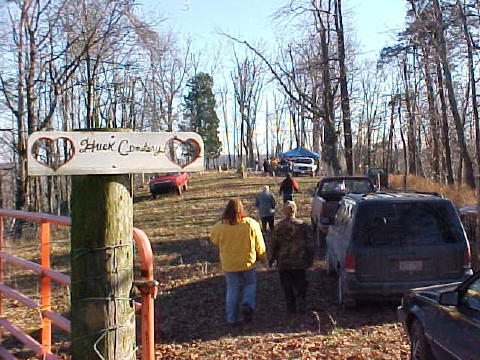SUNNY CAL JOURNAL - Clutching To Memories Of The Husk

It is seldom they return to be buried on their home ground - out the Husk
This week was my Christmas vigil out the Husk, igniting the same remembrances that surface year after year. The bluish-tinted woods were covered by a light snow, the road in better shape than usual.
Most noticeable is they've all left, gone, those with their roots on the Husk, about forty families more or less.
A few years after their exodus to Ohio and other places, they would call up Stump Funeral Home to be brought back and buried in one of the seven or eight cemeteries on the backwoods ridge, one of Calhoun's less populated stretches between Hur and Richardson.
Every now and then, a old soul returns to rest near their origins. A few days ago it was Evelyn Carpenter Husk, whose parents were Commodore and Eula Tanner Carpenter, who lived out the Coon Ridge, first settled in the 1800s by Harrison Coon.
Evelyn's husband Steve spoke tearfully of the old days and hard times, surrounded by his children who have always lived in another land.
(Steve has passed since this article was written)
It was on this ridge you could find "Snuff Box Glory," known by most as Tuttle Hill, where teachers and students rubbed snuff all day long, all having convenient spittoons next to their desks. It is the most recalled school, which also doubled as a house of worship
The burial place of Paulcer McCune, who went AWOL from a Civil War battle to return to his family down on Buckhorn, but then hid in a cave near the ridge's highest peak, now named for him.
Near the Hur end of the Husk was another one-room school which burned to the ground in 1939. It was here the famous election day "Buckhorn Riot" broke-out in 1928. The third school was Pine Grove, hanging on a steep road bank before the drop to Richardson. It closed about 1950.
Down the side paths you could once spot "alters of worship," lean-twos covered by brush, or remnants of rustic shingled log cabins, where families came for Christian revival. There is the short-lived Southern Baptist Church, the only "real" church house built on the ridge, still standing. (Now destroyed by arson)
While hunting you can still climb over rock fences, built to protect crops and keep in pasture animals, no money for barbed wire.
The Fritz house, a home to German immigrants, where on the coldest of days a couple froze to death in the 40s trying get home from Ohio. Other falling down houses, monuments to the past, can be found in the narrow hollers, not fit to raise a garden or graze a cow.
Halfway around the ridge is the finest persimmon tree that ever grew to maturity, frequented by the local bear that wallow the grass to a nubbin to sample the fruit.
Impressively they did survive, those hardy Husk Ridge families, sometimes eating weed soup and eating snow birds to survive the winter.
It is their memory to which I clutch, their names and struggles not to be forgotten, in an otherwise unremarkable backwoods place filled with turkey, deer and coyotes.